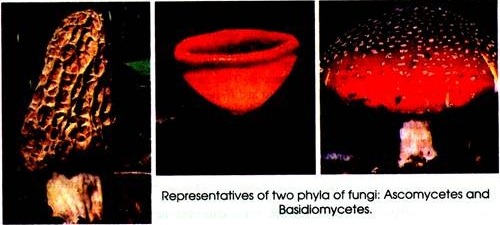ADVERTISEMENTS:
In this article we will discuss about the characteristics of fungi.
The fungi are cosmopolitan in distribution, some are aquatic, others are terrestrial and still others are air borne. Many are parasitic on plants, animals and human beings. The plant body typically consists of branched and filamentous hyphal form, a net like structures called as mycelium.
ADVERTISEMENTS:
The hyphae are aseptate (coenocytic) or septate and uni, bi or multi nucleate. The septa usually have simple pores, but the septa in basidiomycetous genera has dolipore septum. The cell wall mainly consists of fungal cellulose or chitin. These are devoid of chlorophyll but carotenoids are normally present. The fungi are heterotrophic i.e. cannot manufacture their own food; hence these are either parasites, saprophytes or symbionts.
There are three primary divisions of microbial world, based on rRNA sequences. Among them archaea and eubacteria are prokaryotes, while the third group is eukaryotic which contains a true nucleus. They are morphologically complex. Three multicellular eukaryotic kingdoms: fungi, the green plants and animals are grouped in this category but we shall remain confined to fungi.
Fungal cell wall consists of chitin but in some fungi mannans, galactosans and chitisans are also present. All the fungi are chemoorganotrophs, lacking chlorophyll but have simple nutritional requirements. Slime molds are another category of fungi which have morphological similarity of both fungi and protozoa.
They are of two types; cellular slime molds and acellular slime molds. The former are composed of single amoeba-like cells, while the later are naked massess of protoplasm of indefinite size and shape called plasmodia. They live on decaying plant matter and soil and take their food by engulfing bacteria (phagocytosis). The cellular slime mold in Dictyostelin, while acellular is Plasmodium.
ADVERTISEMENTS:
Molds are filamentous fungi associated with bread, cheese of fruits. The mycelium is coenocytic (non-septate), branched, exo- or endogenously borne conidia are produced on the aerial branches. They are asexual reproductive structures of various colours such as black, blue-green, red, yellow or brown. Gametangia develop during sexual reproduction by the fission of specialized hyphae or unicellular gametes to form spores.
When these spores are endogenous, they are called ascospores. They are found in a sac like structure called ascus as in ascomycetes, whereas if exogenous i.e. produced outside, they are called basidiospores which are present at the ends of a club-shaped structure known as basidium as in basidiomycetes.
Yeasts belonging to ascomycetes are unicellular usually spherical, oval or cylindrical and cell division occurs by budding. Generally, yeasts do not form mycelium and remain present in unicellular form. But under certain conditions, baker’s yeasts Saccharomyces cerevisiae forms pseudo-mycelium. Yeast exhibits sexual reproduction i.e. mating by cell fusion to form zygote which forms ascospores. They grow on sugary habitat.
Another major group is basidiomycetes. They are filamentous forming fruiting bodies called basidiocarp. They are also found on dead organic matter in the soil or on the trunks of trees. Sexual spores called basidiospores are produced by them. The fusion of two basidiospores or haploid mycelium resulting in the formation of dikaryotic mycelium. The mycelium grows further to give rise thallus.

